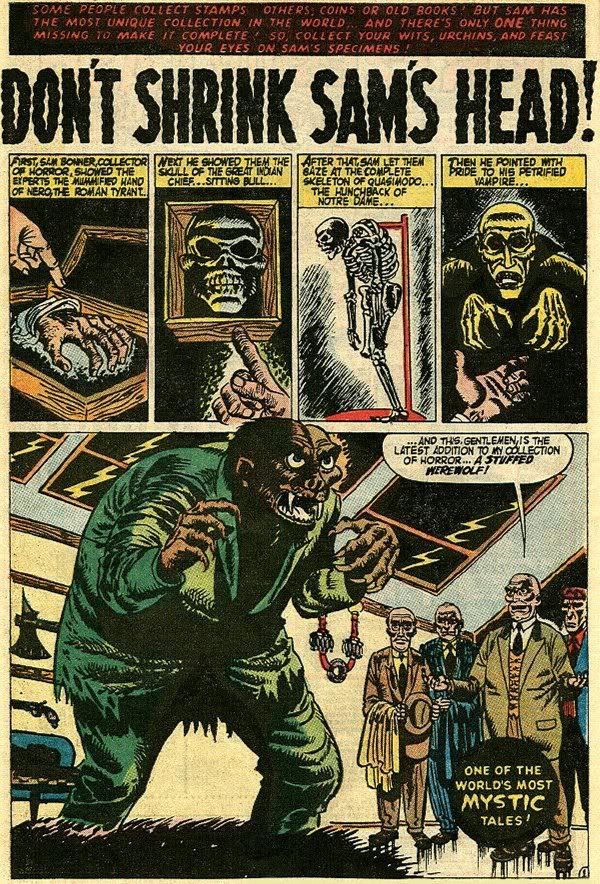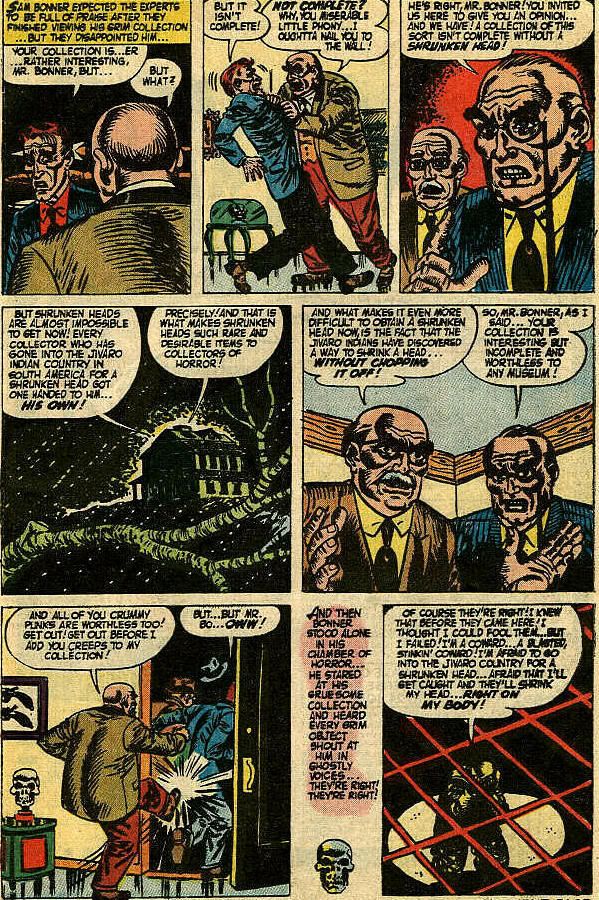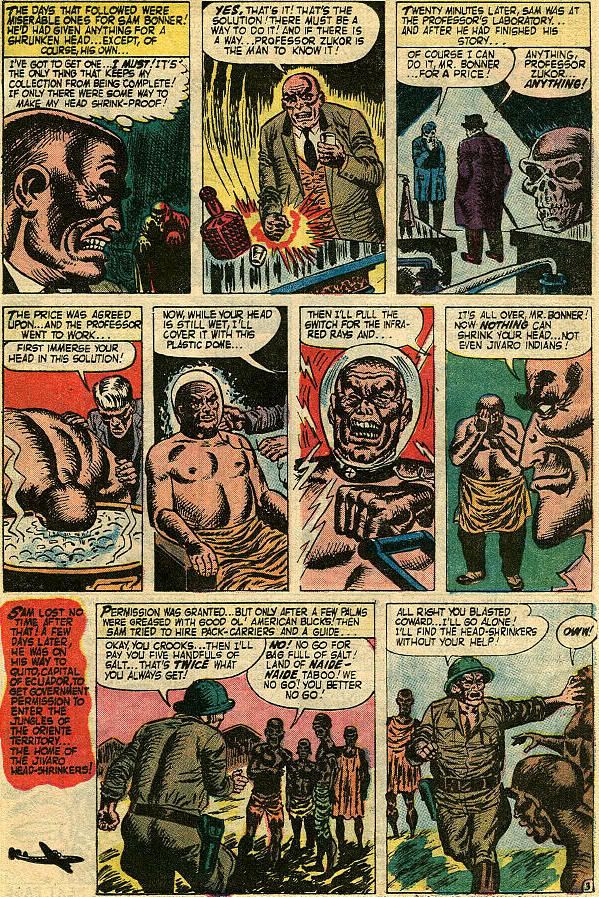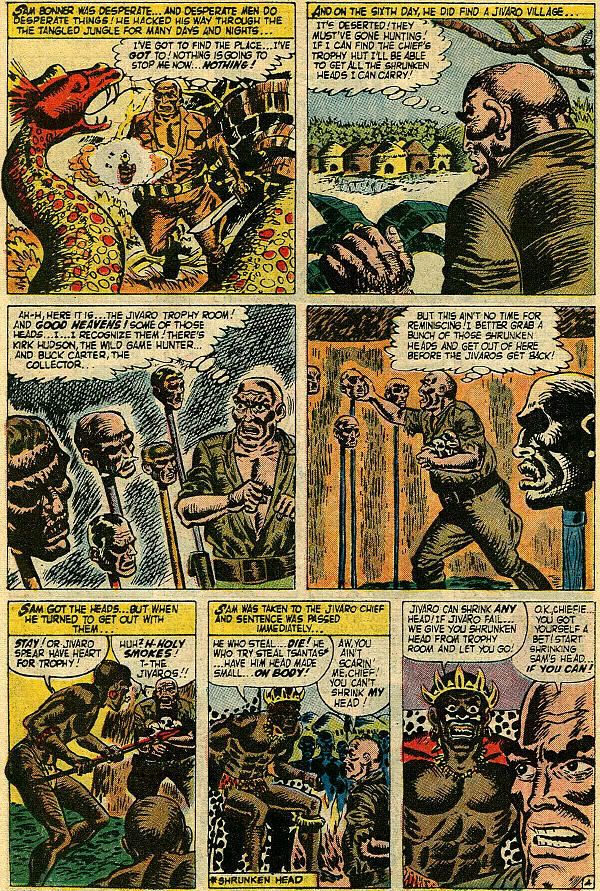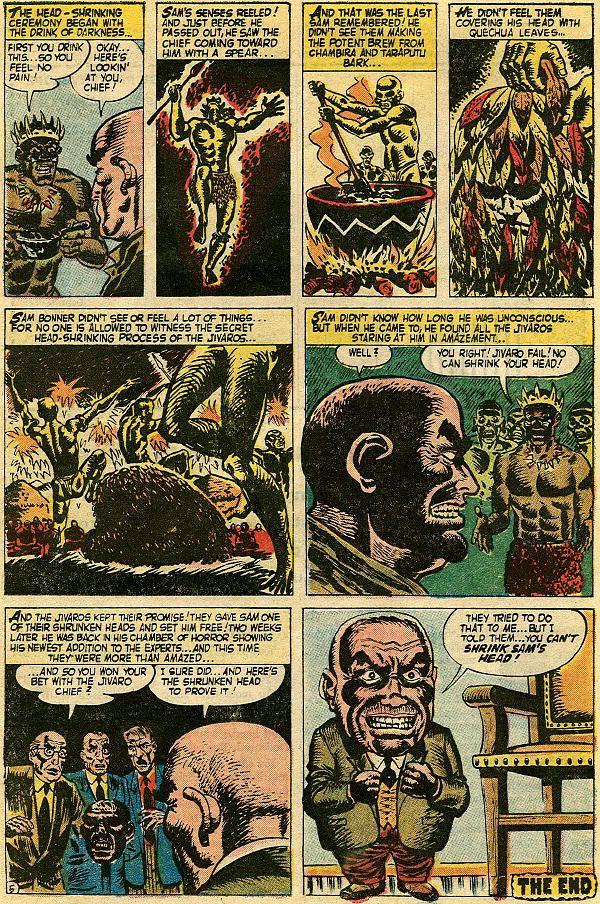Home » Archives for tháng 1 2008
Người đăng:
Unknown on Thứ Tư, 30 tháng 1, 2008
 Number 254
Number 254
Dead man's chest
Bob Oksner sure could draw cute girls. He could draw anything, actually, and was one of DC Comics' best caricaturists. He drew both Jerry Lewis and Bob Hope comics for years, because he had a good humorous style. But it's the pretty girls I like.
Lady Danger was a character from Sensation Comics in the late 1940s. This particular tale came from Sensation Comics #85*, January 1949. It's written by Bob Kanigher, who was editor of that title. In those days DC's artists were told to "draw it like Caniff!" who was one of the most popular newspaper cartoonists in America. Oksner was like the rest of the artists and drew it like Milton Caniff, but then, Caniff also had a way with pretty girls.
Page 1 / Page 2 / Page 3 / Page 4 / Page 5 / Page 6 / Page 7 / Page 8 / Page 9 / Page 10
*According to the Grand Comics Database, it was reprinted in Lois Lane #115, October 1970.
Người đăng:
Unknown on Thứ Hai, 28 tháng 1, 2008
 Number 253
Number 253
Operation Monster
Here's a doctor who thinks it's a good idea to hide his surgical mistakes in the attic. Instead, he should've kept up his malpractice insurance.
"Operation Monster" is from Harvey Comics' Chamber of Chills #5, February 1952. It's drawn by Manny Stallman, who we last saw in Pappy's #128. Heritage Auctions sold the original art in 2004 for $414.00. Here's a scan of the splash page.

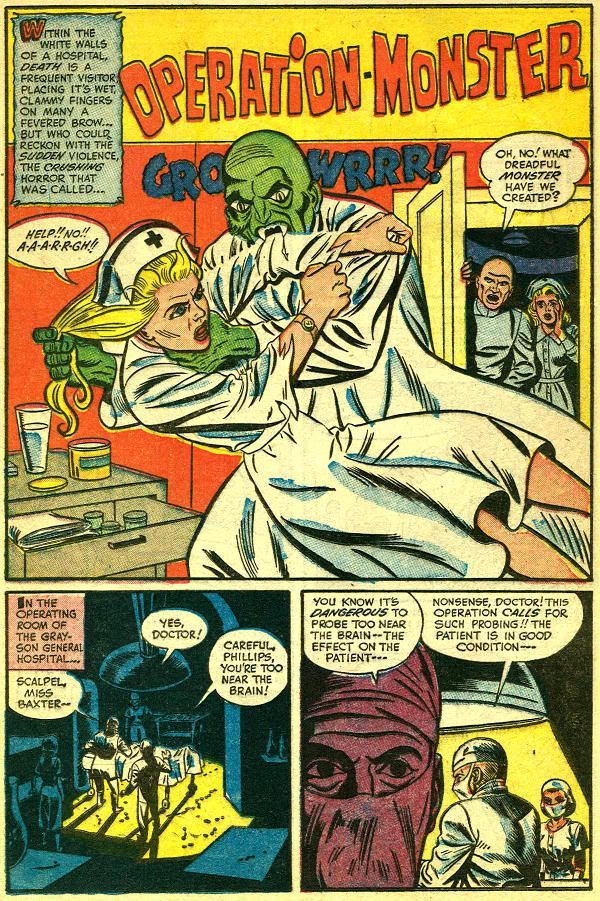
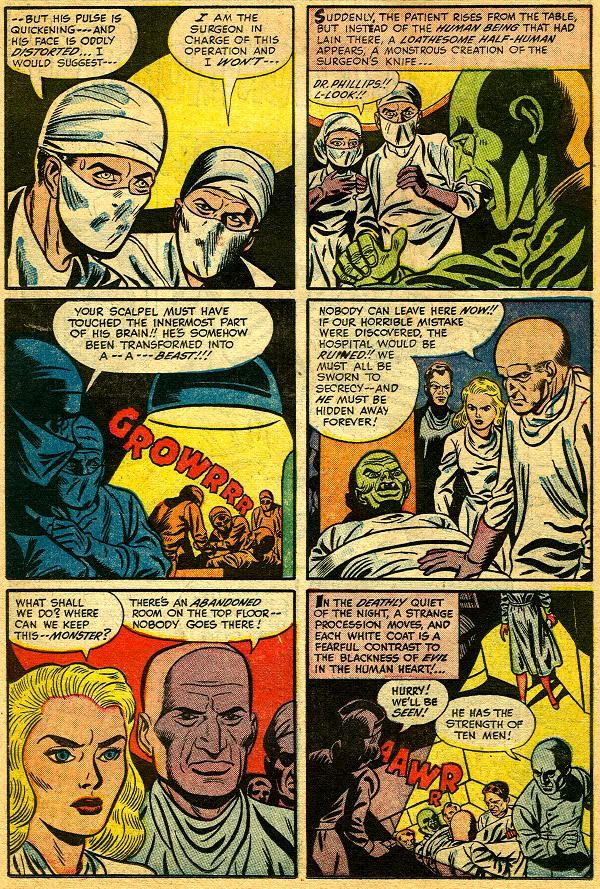
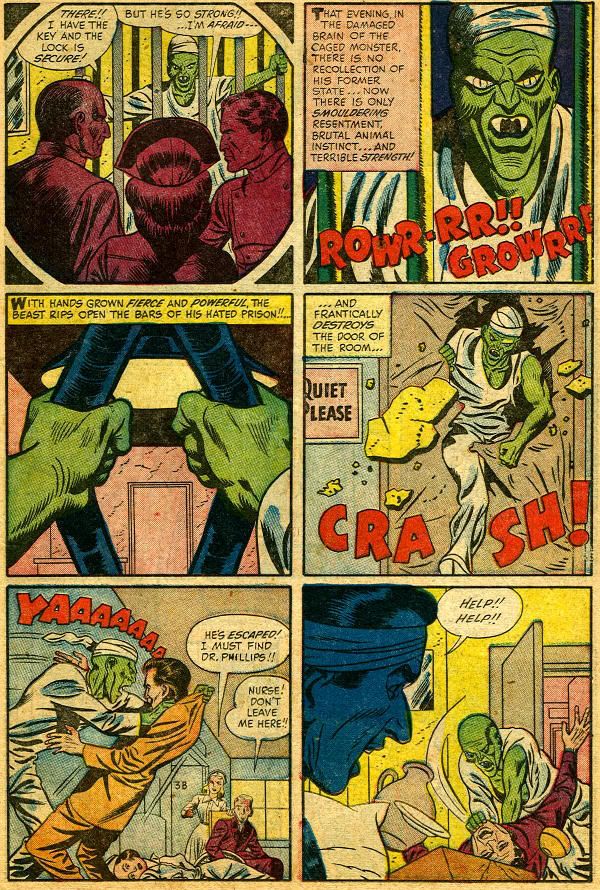
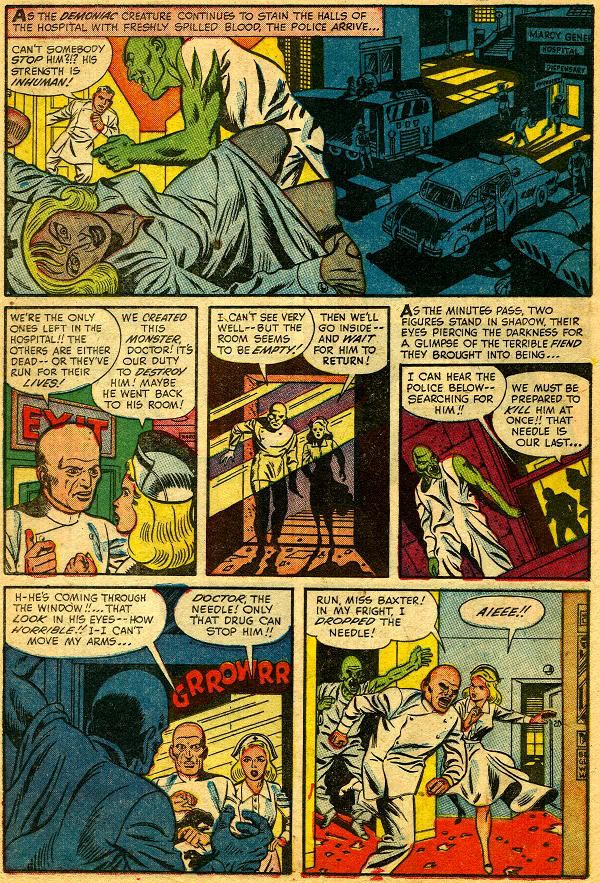
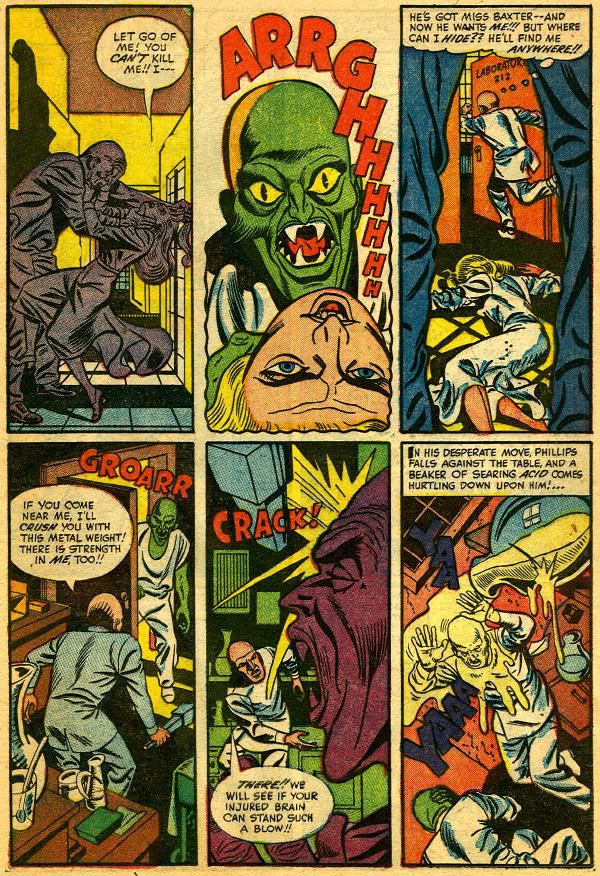
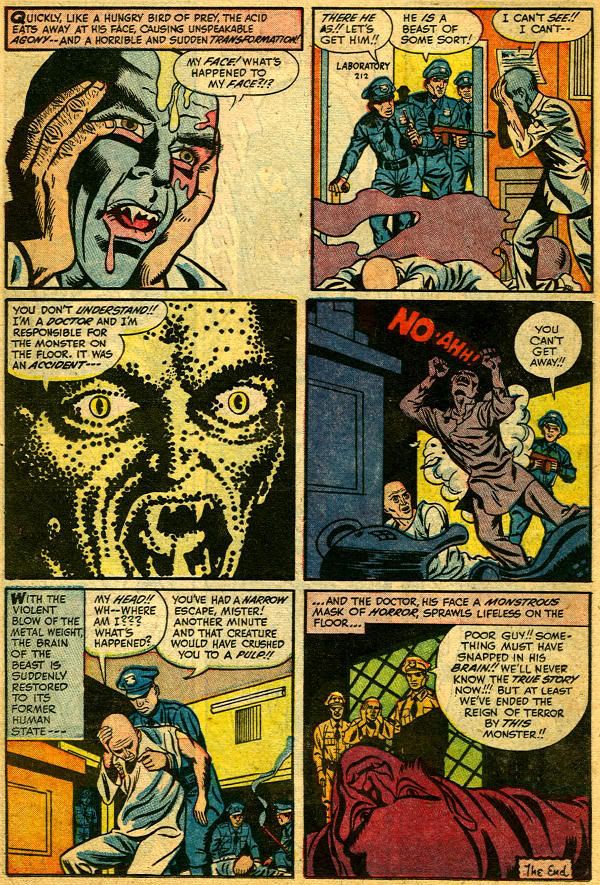
Người đăng:
Unknown on Thứ Sáu, 25 tháng 1, 2008
 Number 252
Number 252
Alan J. Hanley was a real Goodguy
The late Alan J. Hanley was a talented cartoonist/writer who self-published in the 1960s and '70s. He loved Captain Marvel and funny animal comics of the 1940s, and his comic strips are nostalgic pastiches of that era.
"Goodguy" is from his magazine, Comic Book #6, from 1974. It's the second part of a story, but mostly self-contained, so you can figure it out. Hanley could be didactic, but was still entertaining when sharing his political and moral views. In this strip Goodguy and Green Lama of the Limbo League discuss sex and violence in the comics while Goodguy is strapped to a guided missile headed for Disneyland!

Hanley died tragically young. His friend and contemporary, cartoonist Jim Engel, wrote of Hanley in an e-mail to me:
Alan Jim Hanley (he was going by "Alan" when I first met him in person in--I THINK-- 1970. Later he went more by "Jim") was both a friend and cartooning idol of mine. I thought then (and still do today) that his work was just the greatest---both (as you said) modern and nostalgic all at once. Goodguy, The Mitey Buggers, The Spook, Captain Thunder, All-American Jack (I love Goodguy, but my single favorite Hanley story is, I think, "BACK ON THE TRACK WITH ALL-AMERICAN JACK") were all just perfect by my standards. I wrote a memorial thing about him in THE COMIC READER when he died, and I'm pretty sure I said something like "there's nothing I would have liked better than to do the kind of wonderful stories he did", and 27 years later that's STILL true. I had somebody scan a picture I took of him at the San Diego Comicon in 1977. The hotel screwed up our rooms, and Jim, Chuck Fiala & I were given a big suite to share. That was Jim's first time there. On the easel that's Goodguy shouting "Good Garbage!", and Pogo & Albert as Batman & Robin.
 He died in the winter of 1980. He'd driven into the small town he lived in to get his morning coffee & mail. On his way home, his car went off the road & hit a tree. They think he'd blacked out, and the day before he'd complained of a headache/pain . He had a wife and two small daughters. He was 42. Jim's funeral was in a small town called Tomah, Wisconsin, which had cool old metal signs on the lamp posts that pictured Walt & Skeezix, and proclaimed Tomah as the birthplace of Frank King. Chuck & I thought that was kind of appropriate... I often wonder what he could've/would've done in later years if he'd lived. I'd have loved to done some collaborating with him for real as I got better as a cartoonist in those years.
He died in the winter of 1980. He'd driven into the small town he lived in to get his morning coffee & mail. On his way home, his car went off the road & hit a tree. They think he'd blacked out, and the day before he'd complained of a headache/pain . He had a wife and two small daughters. He was 42. Jim's funeral was in a small town called Tomah, Wisconsin, which had cool old metal signs on the lamp posts that pictured Walt & Skeezix, and proclaimed Tomah as the birthplace of Frank King. Chuck & I thought that was kind of appropriate... I often wonder what he could've/would've done in later years if he'd lived. I'd have loved to done some collaborating with him for real as I got better as a cartoonist in those years.
Page 1 / Page 2 / Page 3 / Page 4 / Page 5 / Page 6 / Page 7 / Page 8 / Page 9 / Page 10
Người đăng:
Unknown on Thứ Tư, 23 tháng 1, 2008
 Number 251
Number 251
Who dunnit? Fred dunnit!
Fred Guardineer, one of the best of the early comic book artists, turns in another excellent job with this "Who Dunnit" feature from Crime Does Not Pay #57, November 1947.
Don't worry, Fredfans, I won't make you turn over your monitor to see the solution to the mystery. I've reproduced it right side up.
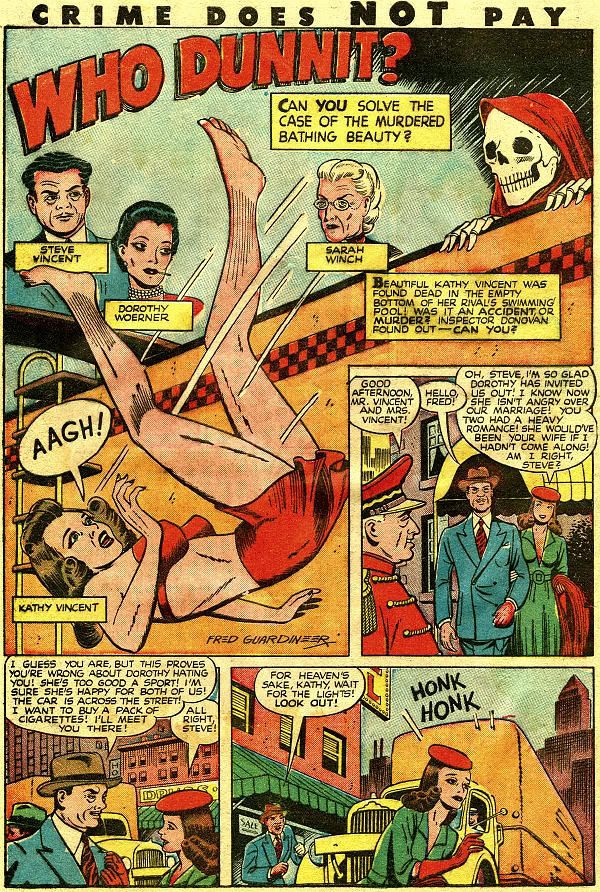

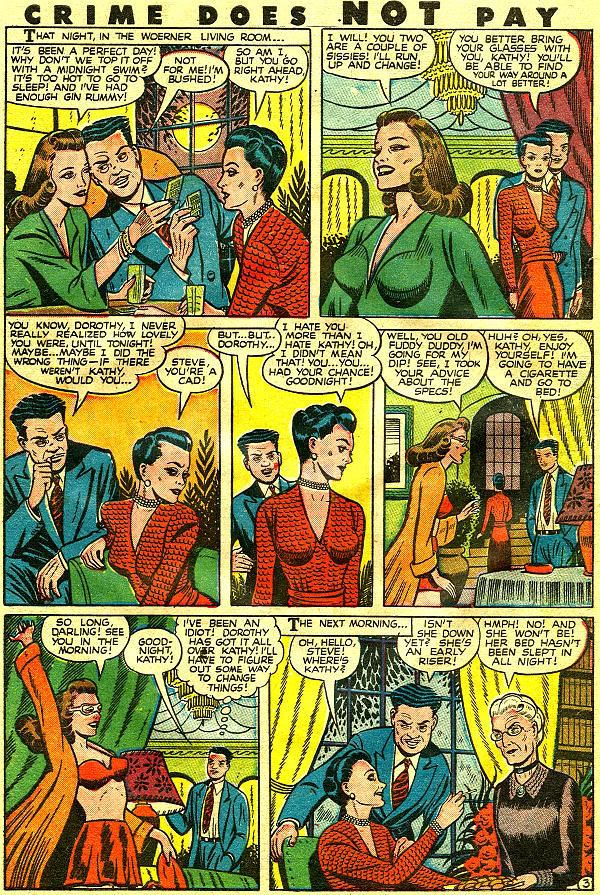

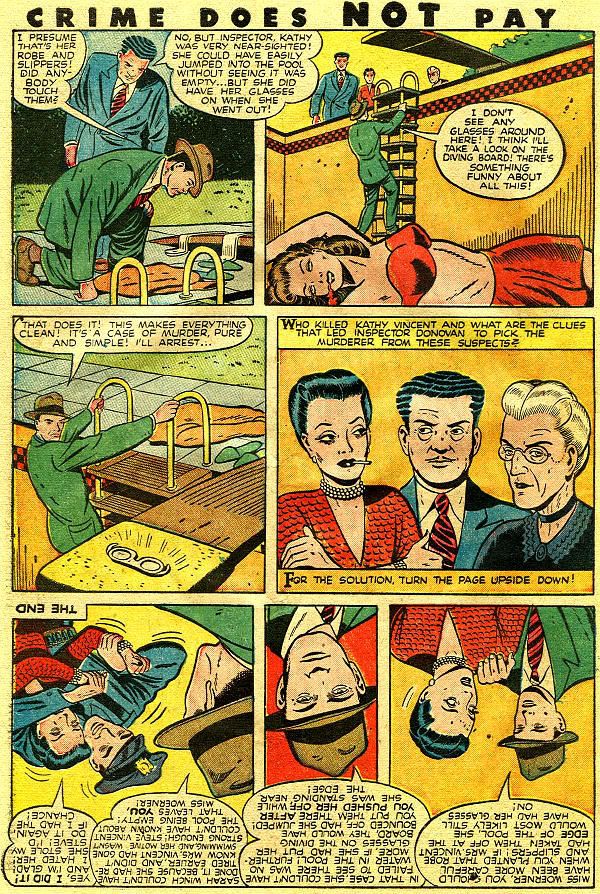
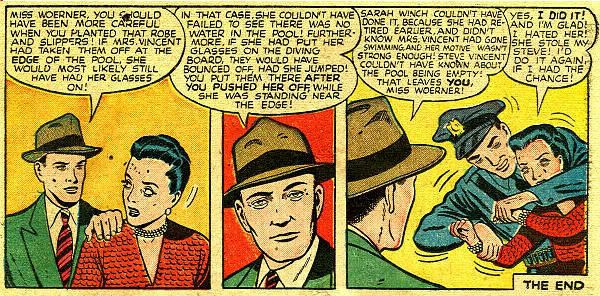
Người đăng:
Unknown on Thứ Hai, 21 tháng 1, 2008
 Number 250
Number 250
Some people call him the Space Cowboy…
It's Pappy's #250, and to mark the occasion I'm bringing you an entire issue of one of the most screwball science-fiction comics ever. Charlton's Space Western Comics was a hybrid from the '50s--combining cowboys and rocket ships--that has to be seen to be believed. The cover of this 1953 issue, #44, has been reprinted several times, but I don't know if the contents have ever been posted online or printed in a book. Probably not, because as you can see by looking, the artwork is amateurish and the stories are, to put it plainly, stupid.
 When you have a story about hydrogen bombs from Mars landing on earth, demolishing "most" of Paris, as well as London, New York, Moscow and the other world capitol, Honolulu, you find yourself in awe of the audacious writing. Two-fisted, Stetson-wearin' cowboy/astronaut Spurs Jackson, with his Space Vigilantes, tracks the radioactive vapor trails of the missiles to Mars, only to encounter Nazis who escaped the Americans at the end of the war. The story was continued in the next issue, which was the last. Space Western was a continuation of a title, Cowboy Western, and after six issues went back to its original title.
When you have a story about hydrogen bombs from Mars landing on earth, demolishing "most" of Paris, as well as London, New York, Moscow and the other world capitol, Honolulu, you find yourself in awe of the audacious writing. Two-fisted, Stetson-wearin' cowboy/astronaut Spurs Jackson, with his Space Vigilantes, tracks the radioactive vapor trails of the missiles to Mars, only to encounter Nazis who escaped the Americans at the end of the war. The story was continued in the next issue, which was the last. Space Western was a continuation of a title, Cowboy Western, and after six issues went back to its original title.
In another story starring Spurs Jackson's pal, the Indian Strong Bow, stone creatures from outer space, resting on earth for 10,000 years, decide it's time to make their move. Strong Bow calls the army base and tells 'em to send an atom bomb, which Spurs delivers, dropping it on the aliens.
On the first page, in the first caption, we're told the year is 1953, so I assume the whole thing takes place in an alternate reality, where a hydrogen bomb will only demolish most of Paris, or one can make a radio call to an army base and order an atom bomb to go.
Page 1 / Page 2 / Page 3 / Page 4 / page 5 / Page 6 / Page 7 / Page 8 / Page 9 / Page 10 / Page 11 / Page 12 / Page 13 / Page 14 / Page 15 / Page 16 / Page 17 / Page 18 / Page 19 / Page 20 / Page 21 / Page 22 / Page 23 / Page 24 / Page 25 / Page 26 / Page 27 / Page 28 / Page 29 / page 30 / Page 31
Người đăng:
Unknown on Thứ Sáu, 18 tháng 1, 2008
 Number 249
Number 249
Tales Too Terrible To Tell
Tales Too Terrible To Tell is a magazine published from 1989 to 1993 dedicated to reprints of old horror comics. It's the old "so bad it's good" syndrome. Or even, "so bad it's really bad," which is also the case with some of the reprints. Either way they're pretty fun. There was an occasional original story and cover. Steve Bissette did the cover for #1. TTTTT also included a section every issue devoted to the publishers of 1950s horror comics. Stories are reprinted in black and white, some from original art in editor George Suarez' collection, some shot in gray tones from color comics .
In checking I see that New England Comics, publishers of TTTTT, still has sets for around $20-$25 available through their online catalogue. That's a bargain, fear fiends.
The series went 11 issues, with numbers 10 and 11 renamed Terrology. Because I answered a survey I got a copy of #10 in a 500-copy variant edition, still titled Tales Too Terrible To Tell. Apparently that's still available from New England Comics, also.











Người đăng:
Unknown on Thứ Tư, 16 tháng 1, 2008
 Number 248
Number 248
"Me and Whizzer McGee…"
Phantasmo, who appeared in Dell Comics' The Funnies #45-63 back in the early 1940s, was really Phil Anson. Thanks to some training by some lamas in Tibet Phil could leave his body, become Master of the World, get really big, get transparent, fly, lift subway trains. He also hung out with a teenager named Whizzer McGee, who took care of his body while his spirit was outside being Phantasmo.
In this episode of the Phantasmo saga he deals with some "magnetic atom time bombs," containing enough U-235 to blow up five city blocks!
 His costume was kind of a non-costume, a cape and a pair of trunks with matching boots.* The art is done in an old-fashioned style by E.C. Stoner.
His costume was kind of a non-costume, a cape and a pair of trunks with matching boots.* The art is done in an old-fashioned style by E.C. Stoner.
My copy of The Funnies #54, from which this story appeared, was used as insulation, along with a stack of other really poor condition comics I got a few years ago. It was near an old furnace, which accounts for the streaks of coal on the first page.
Page 1 / Page 2 / Page 3 / Page 4 / Page 5 / Page 6 / Page 7 / Page 8 / Page 9 / Page 10
*And sometimes Phantasmo wore less than that.
Người đăng:
Unknown on Thứ Hai, 14 tháng 1, 2008
 Number 247
Number 247
Shriek of Araby
This past weekend Karswell showed us a gruesome horror story by Howard Nostrand from 1954. In the story I'm showing from Harvey Comics' Flip #2, also from 1954, Nostrand tries his hand at humor and satire.

Bhob Stewart interviewed Nostrand for Graphic Story Magazine #10, in 1974. Nostrand talked about "The Shriek of Araby." He gave the reason for the color scheme: the movie it's based on, Rudolph Valentino's The Sheik, was a silent film done in sepia tone. The comic book version is a good try, but because of the quick-and-dirty printing of comic books, experiments like this didn't always work out. Some of the panels are too dark, and in the captions the white-on-black lettering is hard to read in spots.
Nostrand liked the story. In part of the 1974 interview he claimed, "That was the one Kurtzman commented on." Stewart asked, "What did Kurtzman say?" Nostrand answered: "He thought it was the best one of the book, and that sort of thing. Didn't mean much 'cause I wrote the rest of the book, too." Later he confessed, ". . .I think I stole it from S. J. Perelman. He did the synopsis in his 'Cloudland Revisited' series. I just sort of changed the plot slightly, and then it said what I wanted. Some of the dialogue is pure Perelman. . .I have a feeling that Perelman doesn't read comic books, anyway, so I wasn't in…you know, when in doubt, plagiarize, but make sure the guy who wrote it doesn't read it." What, plagiarism, in a comic book?!! Say it ain't so, Howard.


Along with "Shriek" I'm including these two "Ulysses" single-page gags by Nostrand, also from Flip #2.
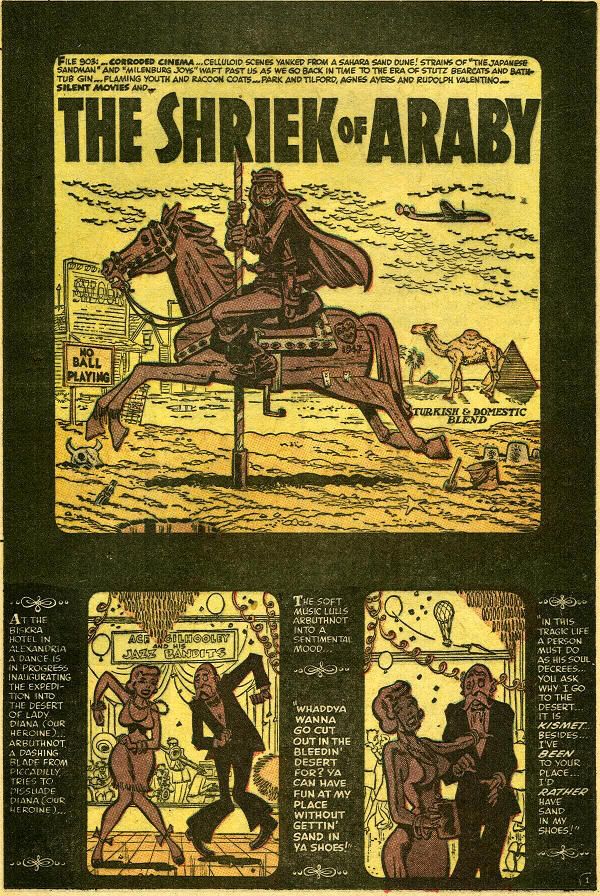
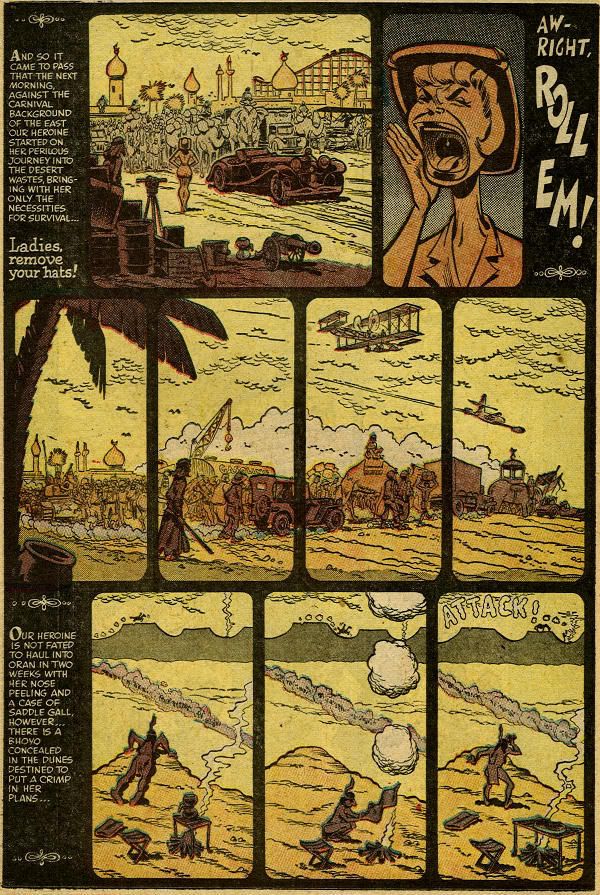
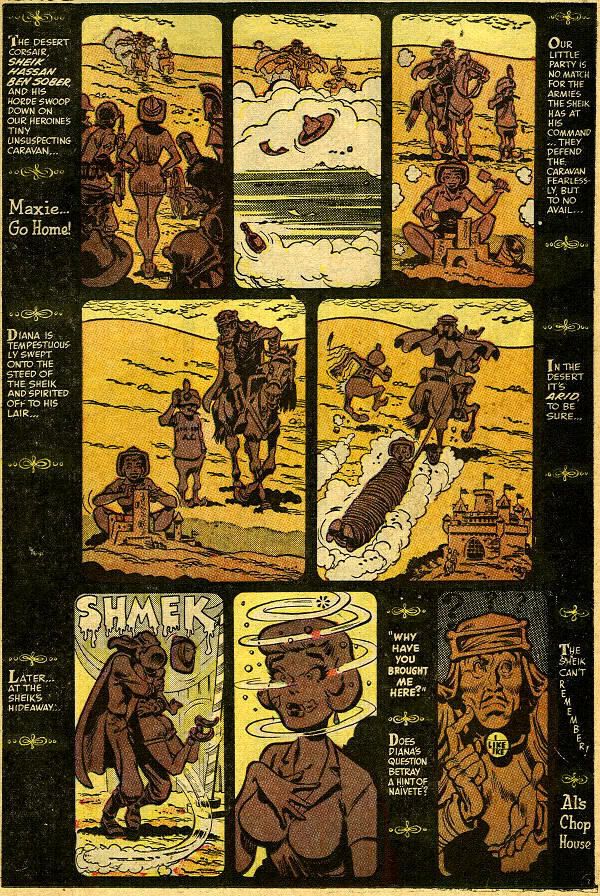
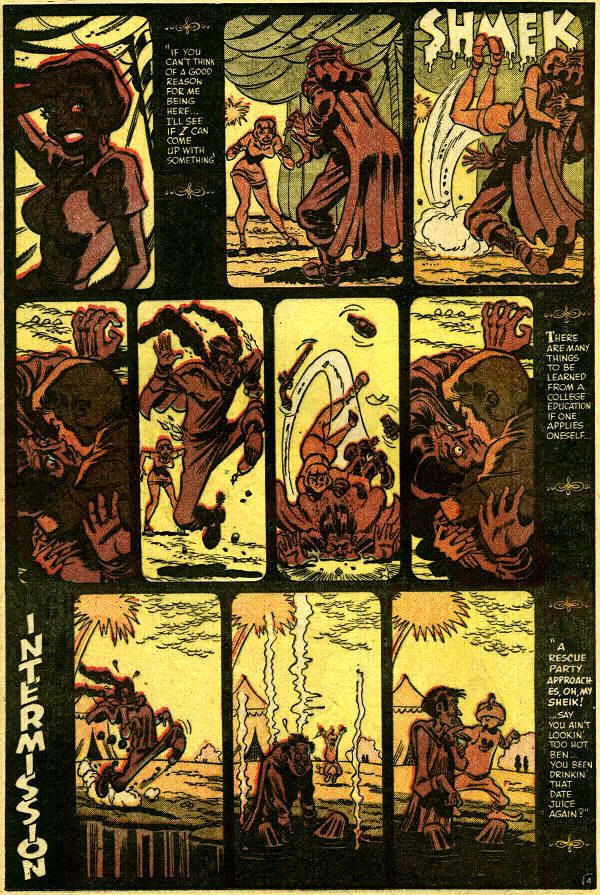
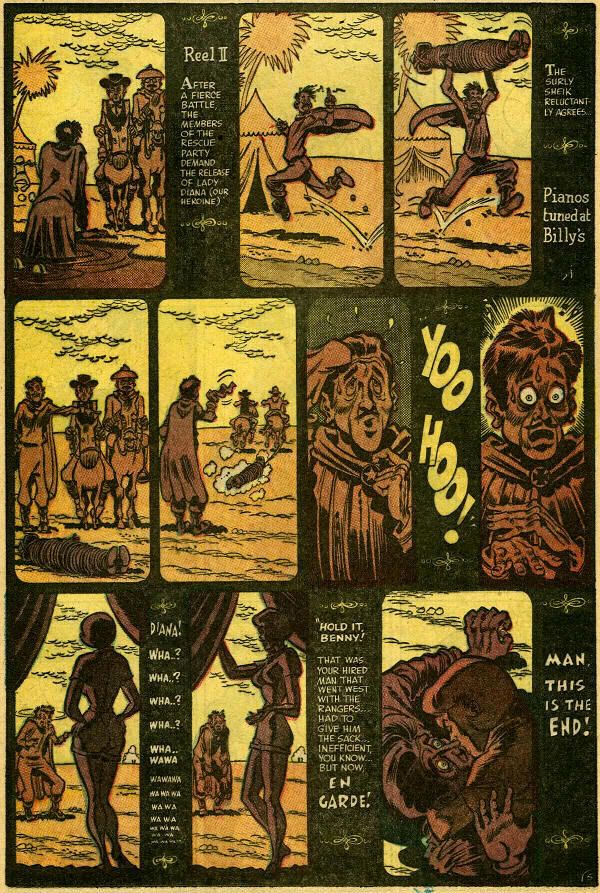
Người đăng:
Unknown on Thứ Sáu, 11 tháng 1, 2008
 Number 246
Number 246
Supermouse and the Timid Giant
What would writers do without fairy tales, nursery rhymes or folk tales? Probably have to actually look for a plot beyond Mother Goose or the Brothers Grimm. The surprise is in the endless variations on such familiar stories. Supermouse and his nephew Roscoe go into Cloud Coo Coo Land for this riff on Jack and the Beanstalk. It's from Coo Coo Comics #40, July 1948. It's derivative, but a cute kid's story, done by an unknown writer and artist.
 Page 1 / Page 2 / Page 3 / Page 4 / Page 5 / Page 6 / Page 7 / Page 8 / Page 9 / Page 10
Page 1 / Page 2 / Page 3 / Page 4 / Page 5 / Page 6 / Page 7 / Page 8 / Page 9 / Page 10
As many comics fans know, Frank Frazetta did some illustrations in the late 1940s for text stories in these funny animal comics . This issue of Coo Coo is blessed with three:



Người đăng:
Unknown on Thứ Tư, 9 tháng 1, 2008
 Number 245
Number 245
Don't Shrink Sam's Head
With a little tweaking I think this story, originally published in Atlas Comics' Mystic #23, could have been published in one of that company's humor titles like Crazy. The last panel is a visual joke, and how many stories open up with a collector displaying a petrified vampire and stuffed werewolf?
The Atlas Tales site lists this story as drawn by Romita? with a question mark, so they aren't sure. I scanned it from the Marvel Comics reprint in Vault Of Evil #6, October 1973.
